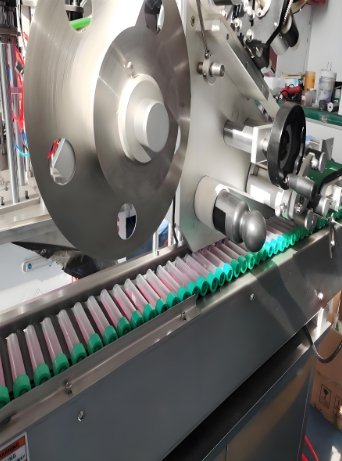
In the chemical industry, precision, safety, and compliance are top priorities. Whether you’re packaging cleaning agents, pesticides, solvents, or industrial liquids, choosing the right labeling machine is critical. The labels must clearly display hazard warnings, batch numbers, and barcodes. The production line also needs to run smoothly and efficiently, often alongside an automatic filling machine.
In this article, we will explore the best labeling machines for the chemical industry, their benefits, and why combining them with automatic filling machines is the best strategy for success.
Why Labeling Is Critical in the Chemical Industry
Chemicals are sensitive and sometimes dangerous. Each container must show exact information. Wrong labeling can lead to health risks, fines, or product recalls. That’s why using a high-quality labeling machine is not optional — it’s essential.
A top-grade labeling machine applies labels quickly and accurately, even when working with oddly shaped bottles or drums. It ensures each label sticks firmly and lines up perfectly every time. These machines reduce human error and meet industry standards, such as GHS (Globally Harmonized System) labeling rules.
What to Look for in a Chemical Labeling Machine
When choosing a labeling machine, think beyond basic function. You need one that:
- Handles various container shapes and sizes
- Works with durable, chemical-resistant label materials
- Is easy to clean and maintain
- Pairs well with an automatic filling machine
- Meets safety and regulatory standards
Let’s look at the top types of labeling machines that suit these needs.
1. Front and Back Labeling Machines
These machines apply labels to both the front and back of flat or round bottles. Many chemical containers are large and rectangular, making this style ideal.
Labeling machines of this type offer:
- Precision placement on both sides
- High-speed operation
- Quick changeovers for different bottle types
When paired with an automatic filling machine, this setup creates a seamless packaging line.
2. Wrap-Around Labeling Machines
For cylindrical containers, such as spray bottles or solvent jars, a wrap-around labeling machine is perfect. It applies one label that wraps fully around the container.
Benefits include:
- 360-degree labeling coverage
- Strong grip on the bottle during application
- Fast speeds without sacrificing accuracy
Wrap-around machines are often used with automatic filling machines that can handle liquids with strong odors or fumes.
3. Top and Bottom Labeling Machines
These machines apply labels to the top or bottom of flat containers. They are ideal for tubs or rectangular bottles commonly used for pastes or solid chemicals.
A top and bottom labeling machine is best used when combined with an automatic filling machine that handles powders or thick materials.
4. Print and Apply Labeling Machines
These machines print labels on demand and apply them instantly. This is very helpful in the chemical industry where batch numbers, expiration dates, and hazard icons must be unique.
Features include:
- Real-time printing
- Custom labeling for each container
- Integration with databases and tracking systems
These labeling machines work well with automatic filling machines that track each bottle’s fill time and contents.
5. Explosion-Proof Labeling Machines
Some chemical factories deal with flammable materials. In these cases, safety comes first. An explosion-proof labeling machine is designed with special materials and electronics to prevent sparks.
They include:
- Sealed enclosures
- Anti-static parts
- Certified safety ratings
These machines can run alongside explosion-proof automatic filling machines, ensuring full safety.
Benefits of Combining Labeling and Filling
Using a labeling machine together with an automatic filling machine offers many advantages:
1. Improved Speed
Both machines work at high speed. They fill and label thousands of containers per hour, cutting production time in half.
2. Better Accuracy
No spills. No crooked labels. The entire line is synced to maintain precision at every stage.
3. Less Waste
Fewer mislabels mean less rejected stock. Less spillage means more usable product.
4. Compliance and Safety
Both machines are built to follow industry safety and labeling laws, reducing the risk of fines or recalls.
5. Cost Efficiency
Fewer workers are needed to monitor the line. This reduces labor costs and increases profits.
Choosing the Right System
Before buying a labeling machine or automatic filling machine, ask these questions:
- What container shapes do you use?
- How many products do you produce per hour?
- Do your labels include barcodes, QR codes, or hazard symbols?
- Do you need to switch between products quickly?
- What safety features are needed for your chemicals?
The answers will help you pick the best system.
Maintenance and Support
A labeling machine needs regular cleaning, calibration, and part checks. Always choose a machine from a company that offers full technical support and spare parts. The same goes for your automatic filling machine. When both machines are maintained well, your production line never stops.
Final Thoughts
The chemical industry has strict rules and high demands. Using a reliable labeling machine ensures that your products are safe, traceable, and legal. When matched with an efficient automatic filling machine, your entire process becomes faster, safer, and more cost-effective.
Investing in the right equipment doesn’t just improve production. It builds trust with customers and keeps your company in good standing. From small batches to mass production, these machines make your job easier.
If you’re looking to upgrade your factory, start with a top-quality labeling machine and automatic filling machine combo. The results will speak for themselves.
